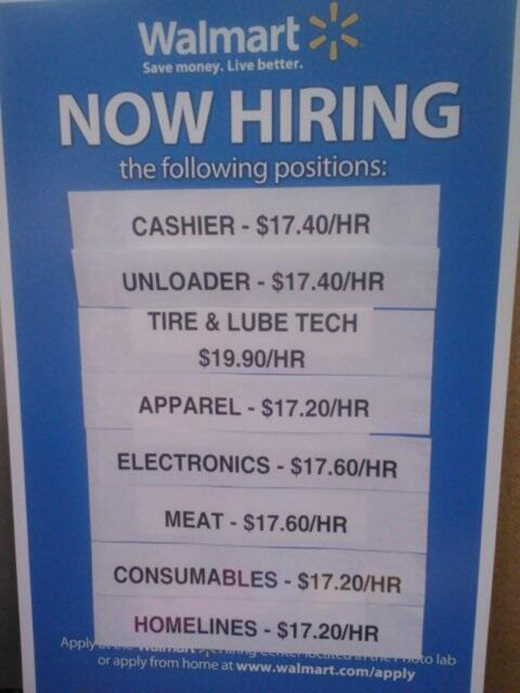
During a visit to Williston, North Dakota, University of Michigan economist Mark Perry snapped this photo advertising entry-level jobs at Walmart starting at over $17 per hour.
DICKINSON, N.D.—As policymakers in Washington, D.C., debate raising the federal minimum wage, entry-level workers in North Dakota enjoy pay levels nearly twice the current federal minimum.
“Effectively, our minimum wage in town is $14 an hour,” claims Shawn Kessel, administrator for the City of Dickinson, a community in North Dakota’s booming oil fields.
Kessel isn’t basing his estimate on any official survey, but rather his own observations. He discusses wages with local business leaders and tracks the wages offered in job listings in his city. He’s convinced the number is accurate, and it is certainly in line with other data and observations in the state.
>>> Infographic: Should We Raise the Minimum Wage?
Wages even for entry-level jobs are so high in North Dakota they sometimes go viral.
Last month, a photo by University of Michigan economist Mark Perry of job listings at a Walmart in Williston showed cashiers commanding wages of more than $17 per hour.
North Dakota has led the nation in personal income growth in six of the past seven years.
>>> Rand Paul: Raise Middle-Class Wages, Not the Minimum Wage
In March, the Bureau of Economic Analysis released a report showing North Dakota’s personal incomes have nearly doubled over the past decade, to more than $57,000 per year. That’s a 93 percent increase from 2003 when incomes in the state were $29,569 per capita.
More remarkable is that North Dakota’s booming incomes come at a time when income growth is slowing in the rest of the country.
Nationally, personal income growth slowed from 4.2 percent in 2012 to 2.6 percent in 2013, but North Dakota nearly tripled the national rate at 7.6 percent. The state also was double the second-ranked state, Utah, which saw 4 percent growth, according to the Bureau of Economic Analysis.



























